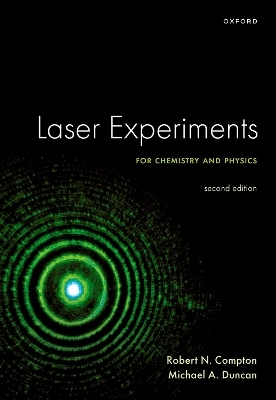
Laser Experiments for Chemistry and Physics, Second Edition
Oxford University Press (Verlag)
978-0-19-890083-2 (ISBN)
Building on the first edition, Laser Experiments for Chemistry and Physics Second Edition includes experiments with new and improved methods and instrumentation. It explores the characteristics and operation of lasers through laboratory experiments designed for the undergraduate curricula in chemistry and physics. Introductory chapters describe the properties of light, the history of laser invention, the atomic, molecular, and optical principles behind how lasers work and the most important kinds of lasers available today. Other chapters include the basic theory of spectroscopy and computational chemistry used to interpret laser experiments and the applications of lasers in spectroscopy and photochemistry. Experiments range from simple in-class demonstrations to more elaborate configurations for advanced students. Each chapter has historical and theoretical background, as well as options suggested for variations on the prescribed experiments.
This text will be useful for undergraduate students in advanced lab classes, for instructors designing these classes, or for graduate students beginning a career in laser science. It can also be used as a supplementary text for courses in molecular spectroscopy or optics.
Robert N. Compton received degrees in physics from Berea College (BA), the University of Florida (MS), and the University of Tennessee (PhD). He was a Senior Corporate Fellow at the Oak Ridge National Laboratory from 1965 to 1995 and was a Professor of Physics and Zeigler Professor of Chemistry at the University of Tennessee until retirement in 2015. He was a Visiting Professor at the University of Aarhus, the University of Paris, and the FOM Institute in Amsterdam. In 2001, he was an Erskine Fellow at the University of Christchurch, New Zealand. He was a Fellow of the APS, AAAS, and OSA, and received the Beams Award from the American Physical Society, and the Meggers Award from the Optical Society of America. His research interests include negative ions, laser spectroscopy, and molecular chirality. He has published one other book with Nathan I. Hammer, Ethan C. Lambert, and J. Stewart Hager entitled Raman Spectroscopy Under Liquid Nitrogen (RUN). Michael A. Duncan was born in Greenville, SC, and attended Furman University (B.S. 1976). He received his Ph.D. (1982) at Rice University with Richard Smalley, working on laser photoionization mass spectrometry. He held an NRC Postdoctoral Fellowship at the Joint Institute for Laboratory Astrophysics (Boulder, CO) with Stephen Leone in 1981-1983. He joined the University of Georgia faculty in 1983 and is now Franklin Professor and Regents' Professor. He is a Fellow of the American Physical Society, the American Chemical Society, and the American Association for the Advancement of Science. He was Senior Editor for the Journal of Physical Chemistry (1998-2015).
1: Elementary Properties of Light
2: Basic Optics
3: General Characteristics of Lasers
4: Laboratory Lasers
5: Nonlinear Optics
6: Laser Safety
7: The Speed of Light
8: The Speed of Sound in Gases, Liquids, and Solids
9: Thermal Lens Calorimetry
10: Laser Refractometry
11: Laser-Induced Breakdown Spectroscopy
12: Laser Desorption Time-of-Flight Mass Spectrometry
13: Multiphoton Ionization Mass Spectrometry of Metal Carbonyls
14: Optical Spectroscopy
15: Quantum Chemistry Calculations
16: Multiphoton Ionization and Third Harmonic Generation in Alkali Atoms
17: Electronic Absorption Spectroscopy of Molecular Iodine
18: Electronic Spectroscopy of Iodine Using REMPI
19: Raman Spectroscopy Under Liquid Nitrogen
20: Raman Spectroscopy of Carbon Nanomaterials
21: Optical Rotary Dispersion of a Chiral Liquid (a-pinene)
22: Faraday Rotation
23: Fermi Resonance in CO2
24: Photoacoustic Spectroscopy of Methane
25: Optogalvanic Spectroscopy
26: Diode Laser Atomic Spectroscopy
27: Raman Shifting and Stimulated Electronic Raman Scattering (SERS)
28: Fluorescence Lifetime of Iodine Vapor
29: Semiconductor Quantum Dots
30: Raman Spectroscopy Applied to Molecular Conformational Analysis
31: Diffraction of Light from Blood Cells
32: Laser Induced Crystal Growth
| Erscheinungsdatum | 14.11.2024 |
|---|---|
| Zusatzinfo | 246 illustrations |
| Verlagsort | Oxford |
| Sprache | englisch |
| Maße | 190 x 245 mm |
| Gewicht | 972 g |
| Themenwelt | Naturwissenschaften ► Chemie ► Physikalische Chemie |
| Naturwissenschaften ► Physik / Astronomie ► Atom- / Kern- / Molekularphysik | |
| Naturwissenschaften ► Physik / Astronomie ► Optik | |
| ISBN-10 | 0-19-890083-X / 019890083X |
| ISBN-13 | 978-0-19-890083-2 / 9780198900832 |
| Zustand | Neuware |
| Haben Sie eine Frage zum Produkt? |
aus dem Bereich


